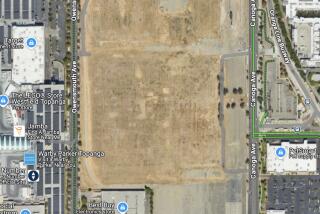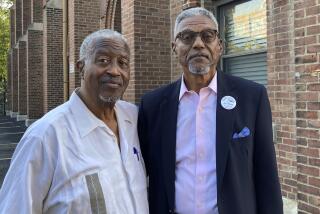Study Finds Rocketdyne Cancer Risk
- Share via
Rocketdyne workers who were exposed to radiation during decades of nuclear testing at the Santa Susana Field Laboratory near Simi Valley have an increased risk of dying of cancer, according to a UCLA report released Thursday.
Rocketdyne immediately criticized the report through a panel of scientists who reviewed it, and called its conclusions overly broad. “Their data doesn’t support their conclusions,” said Michael Ginevan, a biostatistician who reviewed the study for Rocketdyne.
For the record:
12:00 a.m. Sept. 13, 1997 For the Record
Los Angeles Times Saturday September 13, 1997 Home Edition Part A Page 4 Foreign Desk 2 inches; 39 words Type of Material: Correction
Types of cancer--An article in Friday’s editions incorrectly stated the types of increased cancer mortality risks among Rocketdyne workers who were monitored internally for radiation exposure. Workers were at higher risk of death from cancers of the mouth, throat and stomach.
But a state-appointed oversight panel of scientists and community members endorsed the report without dissent, saying the UCLA conclusions are grounds for a similar study of cancer deaths in the neighborhoods surrounding the 2,668-acre field lab.
“The results stand, and they’re very strong,” said David Michaels, a professor of epidemiology at the City University of New York Medical School who serves on the oversight panel.
The UCLA study of 4,563 past and present Rocketdyne workers was launched nearly five years ago after concern about radiation work at the lab prompted neighbors and environmentalists to push for research.
“All available evidence from this study indicates that occupational exposure to ionizing radiation among nuclear workers at Rocketdyne . . . has increased the risk of dying from cancers of the blood and lymph system,” the UCLA study concluded. The report also cited increased risk of mouth, throat and stomach cancer.
The study, headed by epidemiologist Hal Morgenstern and other staff scientists at UCLA’s School of Public Health, found nine more cancer deaths than the expected 91 among workers who were exposed to high levels of radiation from sources outside the body. It found 15 more than the expected 40 among those who breathed in or ingested radioactive materials.
However, the researchers found that the overall cancer death rate at Rocketdyne was lower than that of the general population, a phenomenon known as the “healthy worker” effect, because people who have jobs are generally healthier than those who don’t.
The study also found that cumulative low-level radiation exposure is more dangerous than currently believed under U.S. and international regulatory standards. Based on the observed relationship between cancer deaths and exposures, the Rocketdyne study estimates that cumulative exposure to low-level radiation is six to eight times more dangerous than allowed under current standards, which were extrapolated from studies of atomic bomb survivors.
The panel recommended that, in light of the report, agencies such as the U.S. Nuclear Regulatory Commission revamp their limits for allowable radiation exposure.
But at a Simi Valley news conference, Rocketdyne’s own epidemiological experts voiced doubts about that conclusion and many others in the report, saying the UCLA researchers reached conclusions that were too broad for the limited amount of data gleaned from worker health records.
“There is a continuing review of international standards” for radiation exposure, said David G. Hoel, associate director for epidemiology of the Hollings Cancer Center at the University of South Carolina. “One study is not going to change it, but that will become part of that analysis.”
Dr. Susan J. Knox, a Stanford professor of radiation oncology hired by Rocketdyne to review the UCLA study, said the work is “a well-done study within the limitations of the data. But the numbers were very small, and some of the conclusions were questionable.”
However, the oversight panel--made up of doctors, radiation experts, anti-nuclear activists and Rocketdyne neighbors--drafted a statement backing the study.
The panel recommended continuing to study the Rocketdyne workers, considering a similar study of cancer rates in neighborhoods surrounding the field lab and revising exposure standards.
“I’m concerned about the health and safety of the residents of Simi Valley,” said Dr. Caesar Julian, a panel member and longtime Simi Valley physician. “I think we have to do more studies now.”
Rocketdyne ran 10 nuclear reactors at the rugged mountaintop lab on a contract basis for the Atomic Energy Commission and the Department of Energy from the 1950s to the 1980s.
The work continued through a series of nuclear spills, mishaps and even a partial fuel meltdown in 1959. Rocketdyne’s nuclear research was halted in 1989, but cleanup of the site continues today.
The UCLA team studied the records of all individuals employed by Rocketdyne between 1950 and the end of 1994. That included 4,563 who had worn photographic badges to monitor their exposure to external radiation. Of that group, 2,297 employees had also been monitored to determine how much radiation they had breathed, ingested or absorbed through the skin.
The team looked only at medical records, radiation exposure records and death certificates. They did not examine anyone. They also did not study workers who developed cancer but survived.
Over the 44 years of the study, 258 of the employees died of cancer. The death rate from cancer was actually lower than the population at large and was comparable to other industries that do not involve radiation exposure.
Among those exposed to external radiation, the increases were primarily in leukemias, lymphomas and lung cancer--all types that have frequently been associated with exposure to radiation. The nine excess deaths in this group represented 11.1% of the total deaths among those who received similar exposure.
Among those exposed to internal radiation, the increases were in the same cancers, as well as cancers of the oral cavity, pharynx, esophagus, stomach, bladder and kidneys. Many of those had not been previously linked to radiation exposure. The 15 excess deaths in this group represented 27.3% of the deaths among those who ingested or breathed radioactive materials.
This group included primarily people who fabricated fuel elements, so that they machined uranium and were exposed to dust and shavings.
The study did not explicitly take into account the effects of cigarette smoking or of industrial chemicals other than asbestos or hydrazine, a chemical commonly used as a rocket fuel. That is a particular concern because the types of cancers observed in the study are commonly caused by smoking and by industrial chemicals.
In fact, a similar study of the risks to Rocketdyne employees from such chemicals is currently being conducted by other UCLA researchers.






